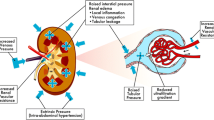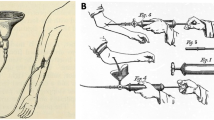Abstract
Objective of this study is to review technical methods to retrieve sperm from critically ill/injured patients after an appropriate family request, possible harmful effects on sperm production/function by ICU medications or concurrent illnesses, and ethical considerations for hospitals and care providers in providing this resource. Design used for this study includes: literature review, PubMed 1998–2009, and authors’ files. There are no interventions. In conclusion, although successful and unsuccessful pregnancies following sperm removal from critically-ill patients are reported, no firm probability predictions for either result are known. Acute and chronic diseases that effect the hypothalamic–pituitary–gonadal axis and multiple medications common to the ICU may reduce sperm production or function. Retrieval methods before and after cardio-respiratory death differ and often require intracytoplasmic sperm injection or other in vitro fertilization techniques to achieve a subsequent pregnancy. The proactive development of a collaborative policy/procedure to identify appropriate roles for the hospital, its employees, and affiliated critical care and urology physicians is strongly recommended.
Similar content being viewed by others
References
Hurwitz JM, Macdonald JA, Lipshitz LV, Batzer FR, Caplan A. Posthumous sperm procurement: an update. [abstract no.P383]. In: Fertility & sterility, Abstract of the scientific oral and poster session, program supplement. Seattle: American Society of Reproductive Medicine; 2002. S242.
Batzer FR, Hurwitz JM, Caplan A. Postmortem parenthood and the need for a protocol with posthumous sperm procurement. Fertil Steril. 2003;79:1263–9.
Strong C, Gingrich JR, Kutteh WH. Ethics of postmortem sperm retrieval. Human Reprod. 2000;15:739–45.
Land S, Ross LS. Posthumous reproduction: current and future status. Urol Clin North Am. 2002;29:863–71.
Hansen M, Kurinczuk JJ, Bower C, Webb S. The risk of major birth defects after intracytoplasmic sperm injection and in vitro fertilization. N Engl J Med. 2002;346:725–30.
Farhi J, Fisch B. Risk of major congenital malformations associated with infertility and its treatment by extent of iatrogenic intervention. Pediatr Endocrinol Rev. 2007;4:352–7.
Ericson A, Kallén B. Congenital malformations in infants born after IVF: a population-based study. Human Reprod. 2001;16:504–9.
Houwen J, Lundin K, SÖderlund B, Bergh C, Kremer JA, Ekerhovd E. Efficacy of percutaneous needle aspiration and open biopsy for sperm retrieval in men with non-obstructive azoospermia. Acta Obstet Gynecol Scand. 2008;87:1033–8.
Chung PH, Yeko TR, Mayer JC, Sanford EJ, Maroulis GB. Assisted fertility using electroejaculation in men with spinal cord injury—a review of literature. Fertil Steril. 1995;64:1–9.
Tash JA, Applegarth LD, Kerr SM, Fins JJ, Rosenwaks Z, Schlegel PN. Postmortem sperm retrieval: the effect of instituting guidelines. J Urol. 2003;170:1922–5.
Marmar JL. The emergence of specialized procedures for the acquisition, processing, and cryopreservation of epididymal and testicular sperm in connection with intracytoplasmic sperm injection. J Androl. 1998;19:517–26.
Schiff JD, Luna M, Barritt J, Duke M, Copperman A, Bar-Chama N. The morphology of extracted testicular sperm correlates with fertilization but not pregnancy rates. BJU Int. 2007;100:1326–9.
Amory JK. Drug effects on spermatogenesis. Drugs Today. 2007;43:717–24.
Nudell DM, Monoski MM, Lipshultz LI. Common medications and drugs: how they affect male fertility. Urol Clin N Am. 2002;29:965–73.
Hamed SA. Neuroendocrine hormonal conditions in epilepsy: relationship to reproductive and sexual functions. Neurologist. 2008;14:157–69.
van Leeuwen E, Wit FW, Repping S, Eeftinck Schattenkerk JK, Reiss P, van der Veen F, et al. Effects of antiretroviral therapy on semen quality. AIDS. 2008;22:637–42.
Fischbach RL, Loike JD. Postmortem fatherhood: life after life. Lancet. 2008;371:2166–7.
Landau R. Posthumous sperm retrieval for the purpose of later insemination or IVF in Israel: an ethical and psychosocial critique. Human Reprod. 2004;19:1952–6.
Kramer AC. Sperm retrieval from terminally ill or recently deceased patients–a review. Can J Urol. 2009;16:4627–31.
Ethics committee of the American Society for Reproductive Medicine. Posthumous reproduction. Fertil and Steril. 2004;82(Suppl 1):S260–2.
Finnerty JJ, Thomas TS, Boyhle RJ, Howards SS, Karns LB. Gamete retrieval in terminal conditions. Am J Obstet Gynecol. 2001;185:300–7.
Lahey Clinic Policy Manual: website http://www.lahey.org/Pdf/Ethics/PDF_Policy/5166.pdf.
McLean SA. Port-mortem human reproduction. Legal and other regulatory issues. J Law Med. 2002;9:429–37.
Middleton SL, Buist MD. Sperm removal and dead or dying patients: a dilemma for emergency departments and intensive care units. Med J Aust. 2009;190:244–6.
Author information
Authors and Affiliations
Corresponding author
Appendix: Lahey Clinic Sperm Retrieval Policy [22]
Appendix: Lahey Clinic Sperm Retrieval Policy [22]
Sperm Retrieval from Dead or Irreversibly Comatose Patients
-
1.
Sperm retrieval from a dead or irreversibly comatose adult male patient may be performed if prior written and notarized documentation from the donor is available stating he authorized retrieval of his sperm after his death or when he became irreversibly comatose. The documentation must also state the name of the adult person who is the intended sperm recipient.
-
2.
Alternatively, sperm retrieval from a dead or irreversibly comatose male patient may be performed if at least one of the patient’s health care providers, who is not an interested party with respect to sperm retrieval, can provide documentation of the donor’s authorization for posthumous sperm retrieval or sperm retrieval while irreversibly comatose. This documentation must include the name of the adult person who is the intended sperm recipient. The health care professional must have documented the patient’s wishes in his written records and must indicate that the patient’s wishes were expressed at a time when the donor was capable of voluntary and informed decision making.
-
3.
If a pre-registered Lahey Clinic patient did not provide prior written authorization for sperm retrieval after his death or when he is comatose, and the appropriate documentation is not available from his health care provider, the person requesting the sperm retrieval shall be informed that judicial authorization for sperm retrieval will be required. Lahey Clinic reserves the right to participation of its counsel in the judicial proceedings. Judicial authorization will only be accepted for those who were registered Lahey Clinic patients prior to the diagnosis of death or irreversible coma. Patients who were not registered Lahey patients prior to death will not be considered for sperm retrieval unless the documentation delineated in Sections 1, or 2, is available.
-
4.
Lahey Clinic will make no attempt to judge, and will not be responsible for the appropriateness of the intended sperm recipient named by the donor as either sperm recipient or as a mother.
-
5.
The person requesting sperm retrieval will be responsible for contacting and contracting with the sperm bank that will cryopreserve and store the collected sperm.
-
6.
The storage and release of any sperm collected at the Lahey Clinic will be the responsibility of the sperm bank authorized by the person requesting sperm retrieval to take possession of the sperm and will not be a responsibility of the Lahey Clinic.
-
7.
Lahey Clinic will make no guarantee as to the quantity, quality, genetic content, safety, viability, or effectiveness of any sperm it collects.
-
8.
Posthumous sperm retrieval must be authorized by the next of kin. In the case of an irreversibly comatose patient sperm retrieval must be authorized by the appropriate surrogate decision maker. In the case of an irreversibly comatose patient, however, sperm retrieval must not, in the judgment of the attending physician, pose an inappropriate medical risk.
-
9.
While the Lahey Clinic will endeavor to honor the wishes of the sperm donor, in case of conflict between the appropriate decision maker and the intended sperm recipient named by the donor, the parties will be advised to seek a judicial determination.
-
10.
Payment for any and all charges related to sperm retrieval will be the responsibility of the individual authorizing the sperm retrieval. Lahey Clinic may collect these charges by any means consistent with standard ethical business practices.
-
11.
No dead body or sex organs will be accepted for transfer to the Lahey Clinic solely for the purpose of sperm retrieval without prior appropriate documentation of compliance with this policy. No irreversibly comatose patient will be accepted in transfer solely for the purpose of sperm retrieval.
-
12.
No Lahey Clinic health care professional will be forced to participate in sperm retrieval from a dead or irreversibly comatose patient, even if authorized or ordered by a court to do so, if doing so would violate his/her religious, professional or personal integrity.
-
13.
Nothing in this policy shall guarantee the availability of this procedure. Sperm retrieval may be performed only if a physician willing and able to perform the procedure is available.
5166 Sperm Retrieval from Dead or Comatose Patients Section 3 Clinical & Administrative Policy & Procedure Manual Page 93-b
-
14.
Prior to sperm retrieval, the person authorizing the procedure will sign a consent form acknowledging understanding of their responsibilities and the limits of Lahey Clinic’s responsibility in the process of posthumous procreation and procreation by the irreversibly comatose patient.
5166 Sperm Retrieval from Dead or Comatose Patients
Clinical & Administrative Policy & Procedure Manual: Section 3 Page 93-a,b Lahey Clinic.
Rights and permissions
About this article
Cite this article
Powner, D.J., Rumohr, J.A. & Lipshultz, L.I. Sperm Retrieval During Critical Illness. Neurocrit Care 12, 445–449 (2010). https://doi.org/10.1007/s12028-010-9333-6
Published:
Issue Date:
DOI: https://doi.org/10.1007/s12028-010-9333-6




